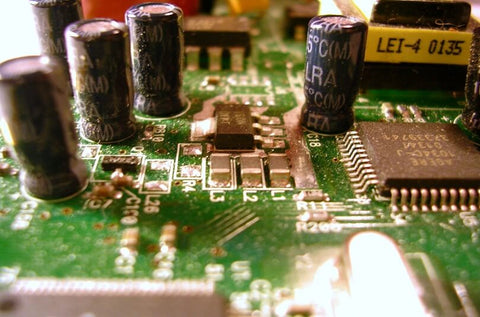
Like all other electronic component parts, a capacitor can fail when subjected to environmental or operational conditions for which the capacitor was not designed or manufactured. The designer must have a clear picture of the safety factors built into the units, of the safety factors he adds of his own accord, and of the numerous effects of the circuit and environmental conditions on the parameters. It is not enough to know only the capacitance and the voltage rating. It is important to know to what extent the capacitance varies with the environment; how much the internal resistance of the capacitor varies with temperature, current, voltage, or frequency; of the effects of all of these factors on insulation resistance, breakdown voltage, and other basic capacitor characteristics which are not essential to the circuit but which do invariably accompany the necessary capacitance.
Why do capacitors fail?
Some of the causes of capacitor trouble are listed below.
Current overload
Transient surges, incurred as a result of switching operations, malfunction of associated circuits or components when of sufficient duration and amplitude produce dielectric failure, permanent shift in capacitance, and failure of seals.
Voltage overload
Voltage transients that exceed the ratings of the capacitor as a result of inadequate warmup procedures, switching, and sudden loss of load may result in internal corona, dielectric puncture, and reduced insulation resistance because of high voltage gradients within the dielectric. Where maximum reliability is desired, the sum of the highest d – c level plus the peak a – c amplitude voltage to be applied must not exceed the working voltage rating of the capacitor. To be safe, the rated working voltage should be at least 20 percent higher than the expected sum of these voltages on all types of capacitors except the electrolytics.
Frequency effects
The effect of frequency on the operational characteristics of the capacitor should be known, particularly the relation between maximum rated current and frequency. Operating a capacitor at a higher frequency than that for which it was designed will result in poor operation and overheating. Capacitors not designed to operate at UHF may puncture when pulses at these frequencies are applied.
Because of the inherent inductance of some types of capacitors, it is a good practice to shunt a large capacitor with a small one, to use the shortest possible leads in looped or crossed configuration, if the maximum bypassing effect is to be secured.
High temperature
Overheating is one of the chief factors which decrease capacitor reliability. Whether incurred as a result of the previously mentioned conditions, high ambient temperatures or high-power factors, excessively high operating temperatures will introduce high failure rates, accelerated capacitance drift, lower dielectric strength, lower corona levels, lower insulation resistance, and shortened life (by one -half for each 10 – C rise in surface temperature). Polar-type capacitors generally have a high-power factor, with resultant self-generated internal heat. The lowered insulation resistance at high temperatures causes larger leakage currents, progressive increases in temperature, further reduction in insulation resistance, and eventual destruction of the capacitor. Hermetic seals, particularly the soft-solder type, are affected by high surface temperatures and temperature cycling, and thus will be inclined to fail at high temperatures.
Pressure
Since capacitance is inversely proportional to the effective distance between the plates, any pronounced pressure variation on nonrigid capacitor containers may produce a change of capacitance. It is immaterial whether the pressure variations are brought about as a result of poor clamp fasteners, rapid altitude changes, or other factors; the end results are the same. Rapid barometric variations may be the cause of hermetic – seal failure, with the resultant exposure of the capacitor elements to environmental conditions. High clamp pressures can also be instrumental in enclosure deformation and eventual seal failure.
Humidity
In addition to causing external corrosion and fungus growths, moisture reduces dielectric strength and dielectric constant, lowers insulation resistance, and causes higher than normal leakage currents; the end results are lowered voltage breakdown and higher internal temperature. Several commonly used capacitor materials (paper, wax, and other impregnants) are fungus nutrients. For maximum reliability under humid conditions, it is definitely advantageous to use hermetically sealed capacitors.
Personnel hazards
The problem of hazards from high–voltage charged capacitors is a serious one. Capacitors should always be completely discharged before they are handled or before any work is done on a circuit or equipment which has a charged capacitor. The practice of shorting the capacitor with a screwdriver is not only dangerous from the standpoint of the operator but is quite likely to destroy the capacitor because of the high discharge currents. Moreover, the dielectric puncture is quite likely to occur.
Time is required to charge and discharge a capacitor, and for safety’s sake, the discharge should take place slowly. Dielectrics that resist polarization on a charge also resist depolarization during the discharge process. A single application of the screwdriver, or other shorting means, will not suffice to completely discharge the stored energy in such a unit. Safe practice indicates the use of a high wattage low – resistance shorting bar which should be applied several times until it is certain that no energy remains in the unit.
